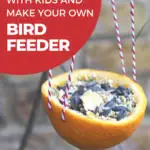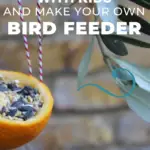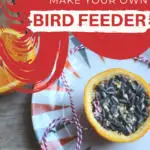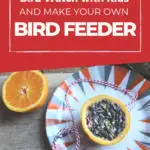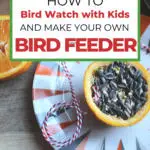Today we are getting back to nature in our 31 Days of Learning with Incredibusy‘s Ali again. When it’s super chilly outside, we like to feed the birds! Which is why in this post Ali shares how to bird watch with kids and make your own bird feeder, too! (Note: all photos in this are copyrighted to Ali’s blog).
There is a long history of garden bird love in our family – years ago we helped our grandmother as she mixed suet and seeds into balls and hung them in the garden for the birds.

We bought peanuts in big bags and placed them in little cylindrical cages to encourage all variety of wing flapping and as we watched from the window, we referenced the robins, the black birds, the sparrows and the green finches.
It’s all about making your garden as attractive a place as possible, for birds to stop for a snack.
Grannies are great at encouraging bird watching – as my boys and their cousins grew up, so their knowledge of garden birds were nurtured and encouraged – with posters on Granny’s kitchen wall, and little checklists and garden workbooks from the RSPB.
Keeping this family tradition alive, we decided to make our own bird feeders, to encourage our own neighbourhood birds into our small urban city back garden.
Materials:
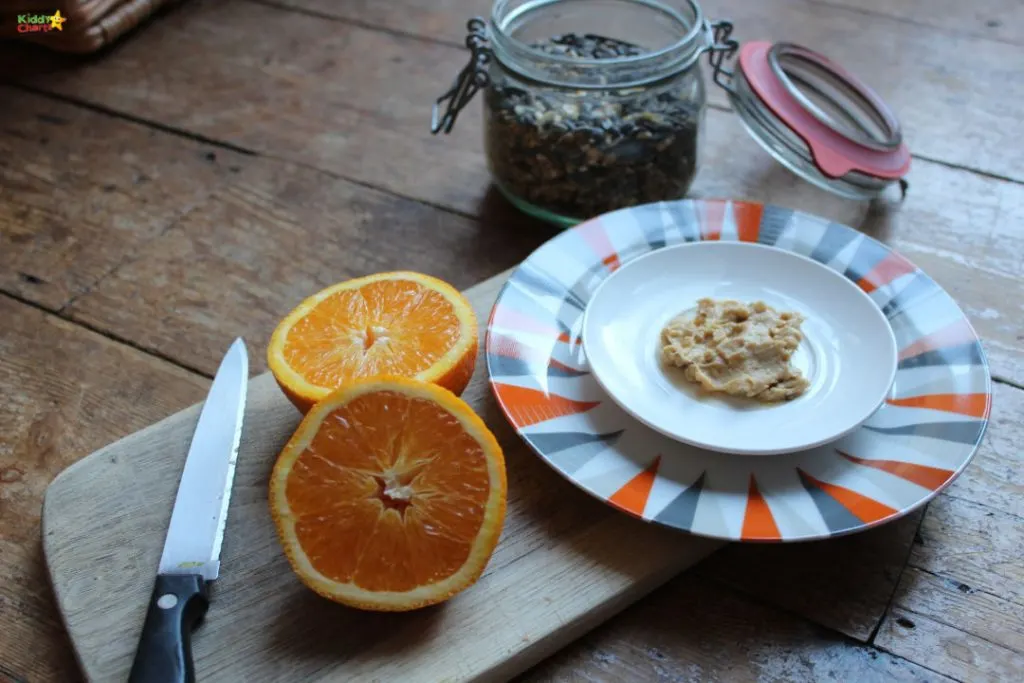
- An orange (a big orange, with a hard skin – not an easy peel satsuma!)
- Any nut butter (we used a natural variety of peanut butter, with no added oil or salt and sugar)
- Bird seed
- A skewer (or sharp pencil)
- String
Instructions for making the bird feeder:
Cut the orange in half, so that you have two ‘cups’.
Using a sharp knife, carve around the inside of the orange half, loosening the flesh from the peel. Then using a large spoon, scoop the orange flesh out and onto a plate.
This ticks a couple of boxes for me, as it means the kids get to eat an orange, healthy, full of vitamin C, and we get to reuse the peel instead of it going into the compost bin.
Now with your skewer or sharp pencil, carefully make two holes equidistant apart on either side of the orange peel ‘cup.’

thread the string through the holes to make it easy to hang the orange peel cup bird feeders in the garden. Make sure that you’ve got the balance right so that the bird feeder hangs level.
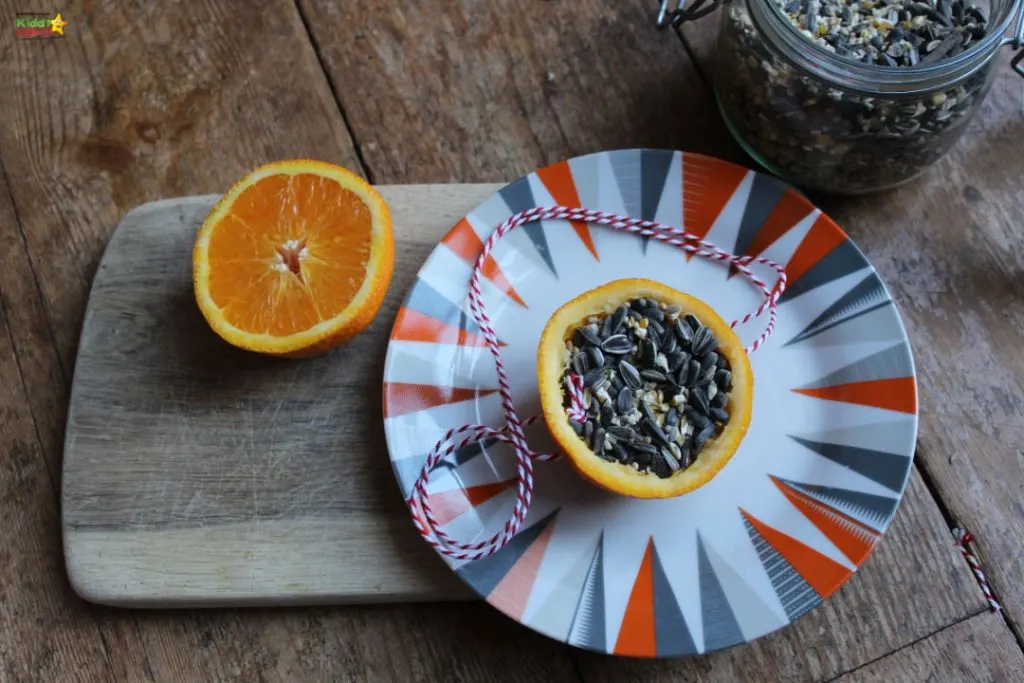
Meanwhile – mix two dessert spoons of peanut butter with the bird seed.
Make your own bird food
You can make your own bird food by combining a variety of seeds, or – and this is extra fun for the non-squeamish teenagers, add some dried meal worms… eugh – but honestly the birds love them!
Add the peanut butter and seeds mix to the hollowed out orange peel cups. Pushing the mixture well in so that it will stay in place.
The RSPB give three top considerations for where to site a bird feeder:
- Quiet – where birds won’t be disturbed,
- Safe – not too close to bushes where cats could hide in wait, but close enough to cover that birds can easily dart to and fro, and
- Sheltered from harsh winds.
Oh, and make sure you can see it when you’re indoors – find a good spot in view of your window so that you can settle in with your note pads and charts, and a pair of binoculars, to register the birds that visit your garden.
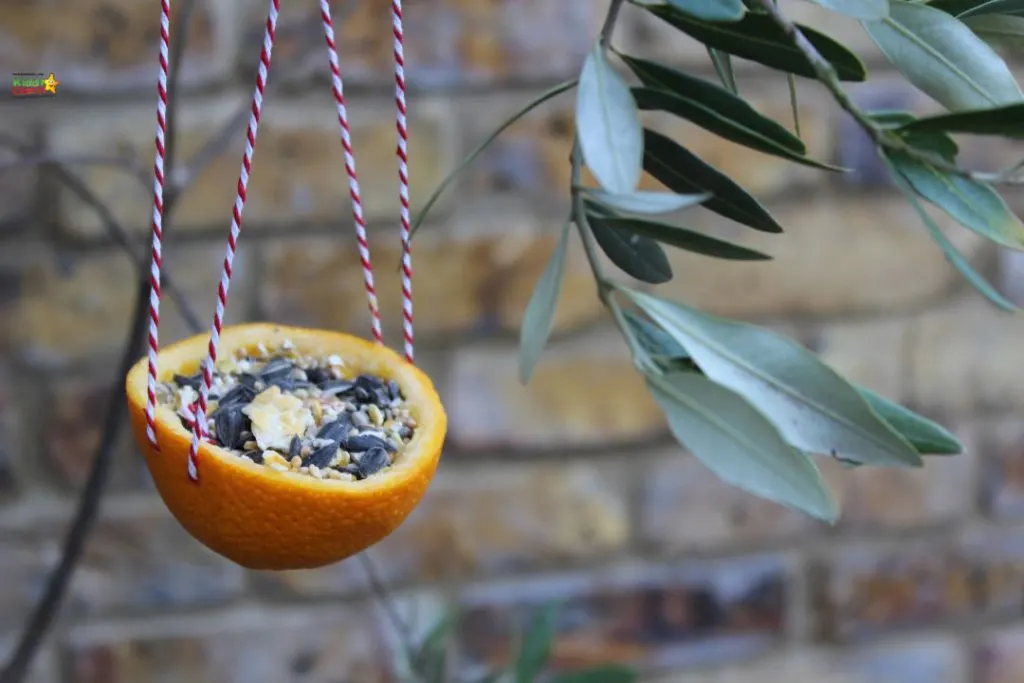
This is a really fun thing to do at home, as well as in the classroom – the lucky birds will love you for preparing a feast for them – and you will enjoy watching and documenting your feathery visitors.
If you want to make this into more of a project, the RSPB run an annual Big Garden Birdwatch in January, this has been going on for forty years now – look out for the hashtag #BigGardenBirdWatch And here’s a list of what you might spot in the garden – jot them down and see how many you can spot.
- Coal tit
- Collared dove
- Dunnock
- Goldfinch
- Great tit
- Greenfinch
- Long-tailed tit
- Magpie
- Robin
- Starling
- Woodpigeon
This is a great way to sharpen the child’s observation skills, and enhance their aptitude for note taking, and indeed drawing ability – as illustrating the birds is another lovely thing to do.
How does this activity work with STEAM practices?
The is a great activity as it spans both science and the arts….
The Science and the Maths
Children will learn about their local bird species, noticing patterns in visits and visitor numbers.
The Arts
Making and hanging the bird feeder, and finding fun places to hang them, alongside drawing the birds that visit the feeder.
We would love to see what you create – do tag us on Instagram where you will find our new account https://www.instagram.com/kidschaos_blog/ use the hashtag #31DaysOfLearning as we are joining in with KiddyCharts creative STEAM project this month.
We trust you love this as much as we do! If you are looking for more activities cover STEAM and beyond, why not check some of these out as well?
Nature related STEM activities
We have a few more nature and outdoor related activities on the blog for you - do take a look....
Home made bird feeders
Another idea for a home made bird feeder to go along with this why - why not make both of them?
How to make bottle cap sail crafts
Get out and about with a little home made sail boat!
How to make a magical tracking stick to look for the wild things in your garden
Make a magical tracking stick for the next time you go for a walk in the woods...
Forest school activities for all seasons
Some more great activities for fun in the forest!
Forest school activities: How to reconnect YOUR kids with nature
And finally, a few more ideas to help kids reconnect with nature in the woods.
If you like this activity, do check out our newsletter for more wonderful printables and ideas every week.
See you here again soon I hope.
Helen

